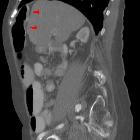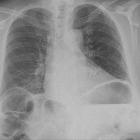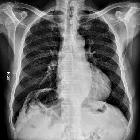Chilaiditisyndrom












Chilaiditi sign refers to the interposition of the bowel, usually colon, between the inferior surface of the right hemidiaphragm and the superior surface of the liver. It may be misinterpreted as a true pneumoperitoneum resulting in unnecessary further investigations and/or therapy (so-called pseudopneumoperitoneum). The presence of pain associated with and attributed to the sign is termed Chilaiditi syndrome.
Radiographic features
Plain radiograph
Features that suggest Chilaiditi sign include:
- gas between liver and diaphragm
- haustra within the gas suggesting that it is within the bowel and not free
CT
If there is a clinical suspicion of abdominal visceral perforation and plain radiographic appearances are unclear, abdominal CT can be performed to clarify whether there is pneumoperitoneum.
CT can clearly demonstrate the presence of interposed colonic loops between the right hemidiaphragm and liver with no free intraperitoneal air.
Treatment and prognosis
Asymptomatic patients with Chilaiditi sign do not require further imaging or treatment.
History and etymology
It is named after Demetrius Chilaiditi (1883-1975) , Greek radiologist who described the radiographic findings in 1910 whilst working in Vienna, Austria . Although the first description of the interposition of colon between the liver and the right hemidiaphragm was published by Cantini in 1865 .
Siehe auch:
und weiter:

 Assoziationen und Differentialdiagnosen zu Chilaiditisyndrom:
Assoziationen und Differentialdiagnosen zu Chilaiditisyndrom:

